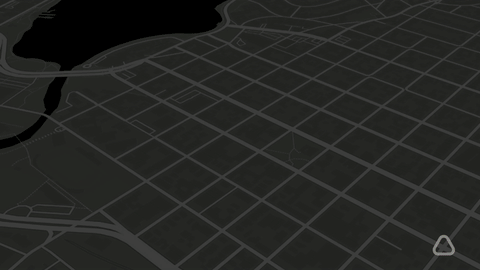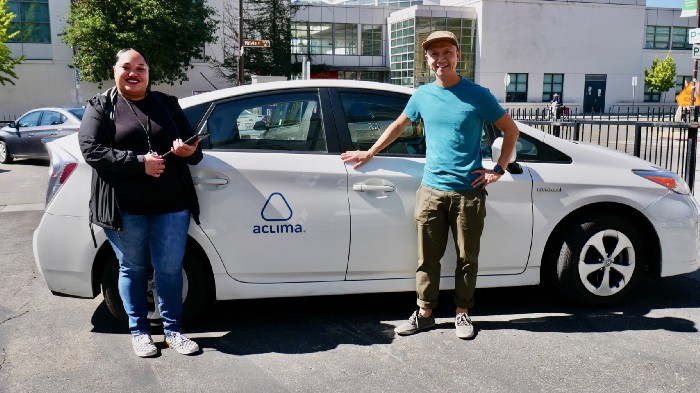Aclima Launches Hyperlocal Air Monitoring in Los Angeles and San Bernardino Counties
In collaboration with environmental justice and climate action leaders, local and state government agency and elected officials, and community members, Aclima launched hyperlocal mobile air monitoring in Los Angeles and San Bernardino counties in California, measuring and analyzing air pollution and greenhouse gases block by block in the East Los Angeles/West Commerce/Boyle Heights and San Bernardino/Muscoy AB 617 communities, as well as throughout the implementation of the Bassett Avocado Heights Advanced Energy Community project.
Aclima’s goal is to deliver air quality insights that reflect the community experience, support emissions reductions planning, and amplify and support existing efforts toward environmental justice.
“When we see these amazing little cars driving by, we should wave and we should smile, and we should consider that they will be mapping the air quality, and we will be able to really pinpoint what is going on in our air, and who is causing it,” said Oralia Rebollo, Mayor Pro Tem, City of Commerce. “That's how we can better address how we move forward and how we hold people accountable.”
Cities like Commerce and San Bernardino and unincorporated areas like Bassett and Avocado Heights are surrounded by freeways, factories, railyards, and warehouses, subjecting residents to emissions from mobile and stationary sources of air pollution throughout the year. Hyperlocal measurement and analysis of air quality will help to locate pollution hotspots that persist over time and can also uncover patterns in pollutant levels at different times of day or day of week.
.png?width=820&name=LA%20and%20SB%20Driving%20Maps%20(2).png)
MAPS: Aclima mobile air monitoring measurement areas in Los Angeles and San Bernardino counties July-Sept 2021
“You can’t argue with the data,” said Ben Reynoso, Council Member, City of San Bernardino, Fifth Ward. “Vehicles like this are instrumental in cleaning the air, and creating the environment that this community deserves.”
Supporting Environmental Justice with Block-level Air Pollution Insights
For years, Aclima has been mapping air quality throughout California and beyond, including in the Richmond-San Pablo, West Oakland, and San Diego AB 617 communities, as well as all nine counties of the San Francisco Bay Area, reaching over 20% of California’s population.
In 2017, California State Assembly Bill 617, written by Cristina Garcia, Assemblymember for District 58, was signed into law. In Bristow Park in Commerce, CA, four years later, Assemblymember Garcia joined Davida Herzl, co-founder and CEO of Aclima, along with environmental justice leaders, community members, the South Coast Air Quality Management District (South Coast AQMD), the California Air Resources Board, and non-profit leaders in a ribbon-cutting ceremony to launch hyperlocal mobile air monitoring in support of AB 617 community-centered emissions reductions planning.
As part of the East LA/West Commerce/Boyle Heights and San Bernardino/Muscoy AB 617 community air monitoring programs, the insights generated through Aclima mobile monitoring will inform emissions reductions plans by identifying pollution hotspots so the most impacted communities can be prioritized.
“I’m so excited for today and excited for the long-term relationship with Aclima to bring this all over the state,” said Cristina Garcia, California State Assemblymember, District 58.
Aclima recognizes that every community has a different history. That’s why we directly partner with local community members, both to operate the network through full-time jobs, and to inform the analysis of the measurements.
“We will have data, we will have research, to be able to move policy, to be able to hold polluters accountable, and have the quality of life that we deserve,” said Laura Cortez, co-director of East Yard Communities for Environmental Justice. “I'm very excited that we get to have local jobs for this, and that we will have no more excuses.”
Bringing Together Environmental Justice Advocates Across Public and Private Sectors with Modernized Air Quality Data Science
Because air pollutant levels can vary up to 800% from one block to the next -- and those hotspots can be persistent for years -- it is essential to measure air quality at the hyperlocal-level to target interventions, prioritize the most vulnerable communities, and track progress over time. This environmental intelligence supports efforts across community groups, businesses, government agencies, and policymakers at the local and regional levels as they work together to accelerate emissions reductions, improve public health, mitigate and adapt to climate change, and support environmental justice.
“Climate change is a real, grave and concerning threat. And because of historical injustices, the people that are most likely to bear the brunt of climate change, and the health impacts of air pollution, are communities of color,” said Davida Herzl, co-founder and CEO of Aclima. “This moment is one that inspires deep concern and anxiety for all of us. But there's also incredible cause for hope, and I see it here today. We are capable of meeting this moment through deep and bold partnership across sectors: regulators, communities, technology innovators, policymakers, and advocates working together to transform the future.”
Aclima environmental intelligence will support the AB 617 community air monitoring and emissions reductions programs in East Los Angeles/Boyle Heights/West Commerce, as well as San Bernardino/Muscoy.
“There is nothing like AB 617 on the planet. It’s a program that is very localized that calls out pollution hotspots,” said Hector DeLaTorre, Board Member, California Air Resources Board. “Before we had sensors that were big contraptions that couldn't be moved easily. And now to be able to load it up in a vehicle and drive around and have the sensors that are smaller, that are lower cost, that are mobile, that increases the frequency and the geography that we can cover with our monitoring. That makes our ability to clean it up that much better.“
Through this process, millions of measurements made up of billions of data points will be made available for analysis to the South Coast Air Quality Management District for the AB 617 communities via Aclima Pro. Aclima Pro is professional cloud-based data analysis software which contextualizes hyperlocal air quality insights with environmental justice screening information to support emissions reductions planning and implementation by regulators, policymakers, and scientists.
“Over the last decades, there has been a quadrupling of vehicles, a doubling of the population and air quality levels have still improved. That said, some communities haven't improved as fast and that's what this program is about -- providing equity to make sure we see improvements in those communities that are hardest hit,” said Wayne Nastri, South Coast AQMD’s executive officer. “Working together with the California Air Resources Board, state legislature, federal government and the U.S. EPA, we can make a difference.”
Later this year, Aclima will release air quality maps and scientific analysis for all three communities through a free, publicly-accessible, web-based portal that provides hyperlocal ambient air quality insights for the measured areas.
Tracking Emissions Reductions Progress in the Bassett Avocado Heights Advanced Energy Community
The Aclima mapping fleet is now also mapping air quality in the Bassett Avocado Heights Advanced Energy Community (BAAEC).
“Our hope is that we can demonstrate success not only in this community but that we can create a blueprint for future projects like this, to help additional communities across the state and beyond,” said Genaro Bugarin, Director of Energy Program Operations, The Energy Coalition (TEC).
As part of the BAAEC team, Aclima is measuring and analyzing baseline hyperlocal air pollutant and greenhouse gas levels within the community, just prior to the launch of phase two of the project funded by the California Energy Commission through the EPIC program’s EPIC Challenge, a design-build competition which began in 2016.
“The Bassett Avocado Heights Advanced Energy Community project will help community members get solar panels installed in their homes along with battery storage,” said Marlene Buenrostro, Community Engagement Specialist, Active SGV. “We're also creating an energy hub along with a vanpooling feature where people are going to be able to use electric vehicles to get to work and a microtransit feature folks can use to get around town and access public transportation.”
Starting in 2020, TEC in partnership with electricity provider Clean Power Alliance will convert nearly 250 low-income households in BAAEC to be powered by solar and storage resources. The project also includes installing electric vehicle charging stations, vanpooling, a micro-transit program, and community outreach. By providing EV infrastructure and zero emission mobility options and by installing local renewable energy, BAAEC is realizing the benefits of a clean grid and electrified transportation.
In coming years, Aclima will return to BAAEC to measure progress made in reducing hyperlocal air pollution and greenhouse gas emissions, with the goal of helping to demonstrate how locally produced renewable and affordable energy improves conditions for local residents and nearby communities.
“It's really going to make some big changes in our community. And it definitely is going to give us that data that we've been waiting for for a very long time,” said Nenetzin Rodriguez, Project Director, Day One.
Catalyzing Bold Climate Action That Addresses Converging Economic, Health, and Climate Crises
Driven by members of the Los Angeles and San Bernardino county communities, the Aclima fleet is measuring and analyzing air pollutants and greenhouse gases including Fine Particulate Matter (PM2.5), Black Carbon, Carbon Dioxide, Carbon Monoxide, Nitric Oxide, Nitrogen Dioxide, Ozone, Methane, and Ethane, block by block and around the clock on every publicly accessible street. This approach to mobile monitoring generates valuable hyperlocal data while also creating jobs with benefits as an entry point to the green economy.
“I would love for my children to go into the green economy,” said Abigail Medina, San Bernardino Unified School District Board Member and AB 617 steering committee member. “I know this is something that many of our students are able to do. It’s about making sure those future jobs exist.”
Share this
You May Also Like
These Related Stories

A historic stride for climate action

Driving Science

/2022_Aclima_Logo_Mist_500px_wR.png?width=501&height=193&name=2022_Aclima_Logo_Mist_500px_wR.png)
